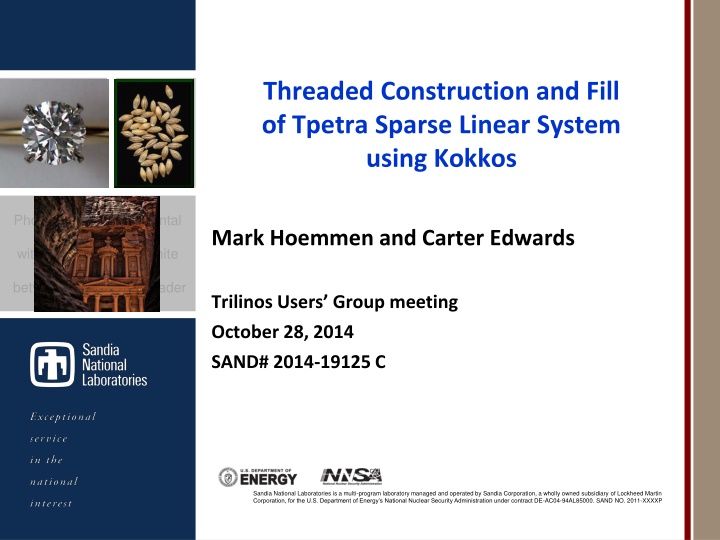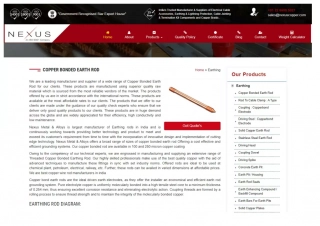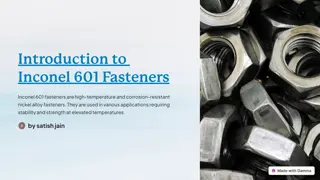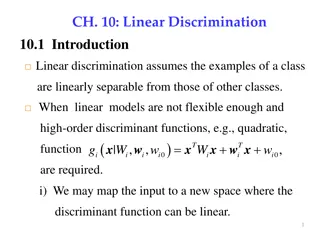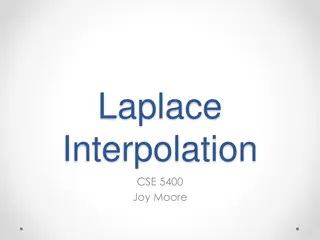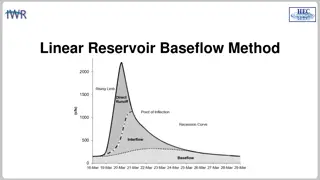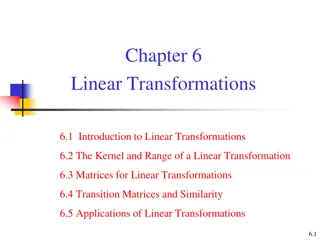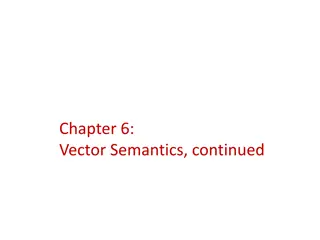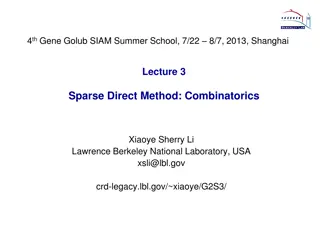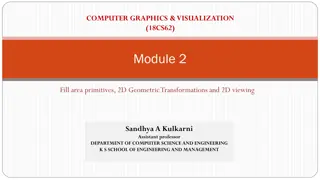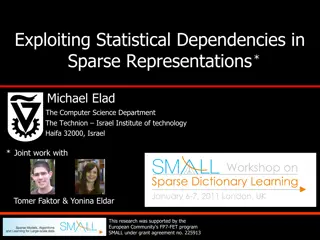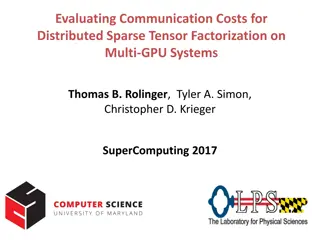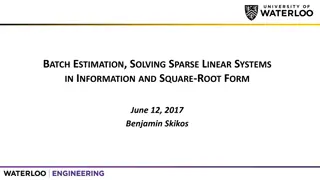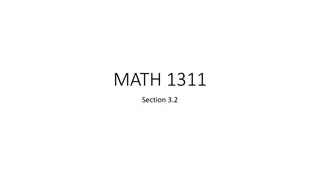Threaded Construction and Fill of Tpetra Sparse Linear System Using Kokkos
Tpetra, a parallel sparse linear algebra library, provides advantages like solving problems with over 2 billion unknowns and performance portability. The fill process in Tpetra was not thread-scalable, but it is being addressed using the Kokkos programming model. By utilizing Kokkos data structures and kernels, Tpetra aims to enhance thread scalability and memory allocation efficiency for MPI+X environments.
Download Presentation

Please find below an Image/Link to download the presentation.
The content on the website is provided AS IS for your information and personal use only. It may not be sold, licensed, or shared on other websites without obtaining consent from the author.If you encounter any issues during the download, it is possible that the publisher has removed the file from their server.
You are allowed to download the files provided on this website for personal or commercial use, subject to the condition that they are used lawfully. All files are the property of their respective owners.
The content on the website is provided AS IS for your information and personal use only. It may not be sold, licensed, or shared on other websites without obtaining consent from the author.
E N D
Presentation Transcript
Threaded Construction and Fill of Tpetra Sparse Linear System using Kokkos Photos placed in horizontal position with even amount of white space between photos and header Photos placed in horizontal position with even amount of white space between photos and header Mark Hoemmen and Carter Edwards Trilinos Users Group meeting October 28, 2014 SAND# 2014-19125 C Sandia National Laboratories is a multi-program laboratory managed and operated by Sandia Corporation, a wholly owned subsidiary of Lockheed Martin Corporation, for the U.S. Department of Energy s National Nuclear Security Administration under contract DE-AC04-94AL85000. SAND NO. 2011-XXXXP
Tpetra: Parallel sparse linear algebra Advantages of Tpetra User can choose data type: float, dd_real, complex, AD, UQ, Can solve problems with over 2 billion unknowns MPI+X parallel (X: any shared-memory parallel programming model) Performance-portable to different node hardware What IS thread-parallel now (& was in Tpetra since ~2008): Sparse matrix-vector multiply (Multi)Vector dot, norm, & update (axpy) Any preconditioner apply that uses these things What s NOT thread-parallel now: Some kernels: e.g., sparse {triangular solve, matrix-matrix multiply} Fill: Creating or modifying the entries of a graph, matrix, or vector We re fixing this using Kokkos programming model & data structures 1
Tpetra fill was not thread-scalable Dynamic memory allocation ( dynamic profile ) Impossible in some parallel models; slow on others Allocation implies synchronization (must agree on pointer) Better: Count, Allocate (thread collective), Fill, Compute Throw C++ exceptions when out of space Either doesn t work (CUDA) or hinders compiler optimization Prevents fruitful retry in (count, allocate, fill, compute) Better: Return success / failed count; user reduces over counts Unscalable reference counting implementation Teuchos::RCP: like std::shared_ptr but not thread safe Not hard to make thread safe, but updating the ref count serializes! Better: Use Kokkos thread-scalable reference counting 2
How will Tpetra make fill MPI+X? Tpetra will use Kokkos data structures & kernels Kokkos objects are natively thread-safe & scalable You ll be able to extract & work with the Kokkos objects Tpetra objects will behave like Kokkos::DualView Simplify port to use GPUs or multiple memory spaces No overhead (& can ignore) if you only have 1 memory space Tpetra objects will have view semantics Copy constructor and operator= will do shallow copy Deep copy is explicit, just like Kokkos Tpetra::deep_copy (nonmember function) 2-argument copy constructor with Teuchos::Copy Will make thread-scalable operations w/ Tpetra objects easier You may still handle Tpetra objects by RCP or shared_ptr if you like 3
Initially, use Kokkos directly for fill Initially, only Kokkos interface is thread-safe & scalable Simplifies backwards compatibility & gradual porting Ensures low overhead Create a Tpetra object by passing in a Kokkos object Create & fill local Kokkos data structure in thread-parallel way Pass it into Tpetra object s constructor Tpetra object will wrap & own the Kokkos object Modify existing Tpetra object through Kokkos interface Ask Tpetra for its Kokkos local data structure, & modify that Tpetra s interface for modifying data will evolve Only serial (no threads) at first; this will change gradually Will always work on host (not CUDA device) version of data 4
Tpetra DualView semantics Get a host view of the data & treat it as read-only Get a device view of the data & treat it as read-only If you only have one memory space, you can ignore all of this; it turns to no-ops. Manually mark host as modified Host & device data are in sync Manually mark device as modified Preferred use with two memory spaces: 1. Assume unsync d 2. Sync to memory space where you want to modify it (free if in sync) 3. Get & modify view in that memory space 4. Leave the Tpetra object unsync d Modify data through Tpetra's interface (host only) Get Kokkos view of device data & modify it Get Kokkos view of host data & modify it Tell Tpetra to synchronize from host to device Tell Tpetra to synchronize from device to host Tpetra objects will act just like Kokkos::DualView. Tpetra s evolution of legacy fill interface is host only. To fill on (CUDA) device, must use Kokkos interface. 5
Example of DualView use Tpetra::Vector< , Cuda> X (map); { // Some code that works on CUDA X.sync<Cuda> (); // copy changes to CUDA device only if needed X.modify<Cuda> (); // we re changing in CUDA space auto X_lcl = X.getLocalView<Cuda> (); parallel_for (X.getLocalLength (), [=] (const LO i) {X_lcl(i) = }); } // done w/ CUDA. Don t sync unless will change on host. { // Some code that works (only) on host X.sync<Host> (); // copy changes to host memory only if needed X.modify<Host> (); // we re changing in host space auto X_lcl = X.getLocalView<Host> (); parallel_for (X.getLocalLength (), [=] (const LO i) {X_lcl(i) = }); } // done changing on host. Skip sync & modify if only 1 space. 6
Timeline Done Crs{Graph, Matrix} & MultiVector use Kokkos objects & kernels Their constructors take Kokkos objects; see TrilinosCouplings FENL MultiVector implements DualView semantics Map implements view semantics; new Map works on CPUs Interface changes left: MUST finish by Trilinos 12.0 in April Make Crs{Graph, Matrix} & Map implement DualView semantics Firm up Kokkos objects interfaces & typedefs in Tpetra Critical thread-parallel kernels to implement Not needed for Trilinos 12.0, but we want them soon! Sparse triangular solve (prototypes exist) & relaxations Multigrid setup: Sparse matrix-matrix multiply, aggregation 7
How did we do it? 2 Tpetra versions now coexist: Classic & Kokkos Refactor Both build & pass all Tpetra & downstream solver tests We maintained backwards compatibility if possible (mostly was) You can test both versions in the same code! Partial specialization on the Node template parameter Classic Tpetra uses Nodes in KokkosClassic subpackage Kokkos Refactor Tpetra uses Nodes in KokkosCompat subpackage Look in packages/tpetra/src/kokkos_refactor for implementations How do I enable Kokkos Refactor RIGHT NOW? Look in packages/tpetra/ReleaseNotes.txt Enable KokkosCore & 5 other subpackages explicitly Set CMake option (Tpetra_ENABLE_Kokkos_Refactor:BOOL=ON) Set default Node type via CMake, or specify it explicitly 8
Schedule for releasing new Tpetra Will deprecate Classic at 11.14 release in January 11.14: Kokkos will build in Trilinos by default (Primary Tested) Using old Node types will emit deprecate warnings Plan to remove Classic at 12.0 release in April Don t worry, MPI only will remain default (Kokkos::Serial device) Best practice: Do NOT specify Node template parameter explicitly Rely on default Node type unless you really care Prefer to change default Node type via CMake option Find default from typedefs: e.g., Tpetra::Map<>::node_type Early adopters: Get in touch with us! 9
MiniFENL: Mini (proxy) Application Finite element method to solve of nonlinear problem via Newton iteration Simple scalar nonlinear equation : ? ? + ??= ? 3D domain: simple XYZ box Restrict geometry and boundary conditions to obtain analytic solution to verify correctness Linear hexahedral finite elements: 2x2x2 numerical integration Non-affine mapping of vertices for non-uniform element geometries Compute residual and Jacobian (sparse matrix) Solve linear system via simple conjugate gradient iterative solver Focus: Construction and Fill of sparse linear system Thread safe, thread scalable, and performant algorithms Evaluate thread-parallel capabilities and programming models 11
Thread-Scalable Fill of Sparse Linear System MiniFENL: Newton iteration of FEM: Thread-scalable pattern: Scatter-Atomic-Add or Gather-Sum ? Scatter-Atomic-Add + Simpler + Less memory Slower HW atomic Gather-Sum + Bit-wise reproducibility Performance win? Scatter-atomic-add ~equal Xeon PHI 40% faster Kepler GPU Pattern chosen Feedback to HW vendors: performant atomics ??+?= ?? ? ?(??)?(?? 0.35 Matrix Fill: microsec/node Phi-60 GatherSum Phi-60 ScatterAtomic Phi-240 GatherSum Phi-240 ScatterAtomic K40X GatherSum K40X ScatterAtomic 0.3 0.25 0.2 0.15 0.1 0.05 0 1E+03 1E+04 1E+05 1E+06 1E+07 Number of finite element nodes 12
Using Kokkos atomic-add interface Kokkos::View<double*> residual ; // global Kokkos::CrsMatrix<...> jacobian ; // global // parallel compute of element[ielem] residual and jacobian double elem_res[NN]; double elem_jac[NN][NN]; for ( int i = 0 ; i < NN ; ++i ) { const int row = elem_node_index( ielem , i ); if ( row < residual.dimension_0() ) { // locally owned row Kokkos::atomic_fetch_add( & residual(row), elem_res[i] ); for ( int j = 0 ; j < NN ; ++j ) { const int entry = elem_graph_map( ielem , i , j ); Kokkos::atomic_fetch_add( & jacobian.values(entry) , elem_jac[i][j] ); } } } 13
Performance Overhead of Atomic Add 0.25 Matrix Fill : microsec/node 0.2 Phi-240 ScatterAtomic 0.15 Phi-240 ScatterAdd (with errors) Kepler ScatterAtomic 0.1 Kepler ScatterAdd (with errors) 0.05 0 1E+03 1E+04 1E+05 1E+06 1E+07 Number of finite element nodes Performance analysis: replace atomic-add with y += x ; Numerical errors due to thread unsafe race condition Approximate performance of perfect atomics or coloring algorithm Kepler: Large overhead for double precision CAS loop atomic Phi: Small overhead versus element computation 14
Thread Scalable CRS Graph Construction Thread scalable construction (reconstruction) pattern a. Count in parallel b. Allocate (resize) c. Fill in parallel d. Compute in parallel Construction of CRS Graph from Element-Node connectivity a. Generate elements unique node-node pairs (graph edges) Count non-zeros per row (graph vertices degree) b. Prefix-sum non-zeros per row for CRS row offset array c. Allocate CRS column index array d. Fill CRS column index array e. Sort each row of CRS column index array Following pseudo-code is simplified to illustrate algorithm 15
CRS Graph Edges (non-zero entries) Generate elements unique node-node pairs Kokkos::UnorderedMap< pair<int,int> > nodenode( nn ,capacity); Kokkos::parallel_for( num_elem , [=]( int ielem ) { for ( int i = 0 ; i < NN ; ++i ) { const int row = elem_node_id( ielem , i ); for ( j = i ; j < NN ; ++j ) { const int col = elem_node_id( ielem , j ); const pair<int,int> key( min(row,col), max(row,col)); auto result = nodenode.insert( key ); if ( result.success() ) { // First time inserted if ( row < row_count.dimension_0() ) Kokkos::atomic_fetch_add( & row_count(row) , 1 ); if (col != row && col < row_count.dimension_0() ) Kokkos::atomic_fetch_add( & row_count(col) , 1 ); } } } ); 16
CRS Graph Row Offset Array Parallel prefix-sum row counts and allocate column index array Kokkos::parallel_scan( num_rows , [=]( int irow , int & update , bool final ) { // parallel scan is a multi-pass parallel pattern // In the final pass update has the prefix value if ( final ) graph.row_map( irow ) = update ; update += row_count( irow ); if ( final && num_rows == irow + 1 ) graph.row_map(irow+1) = update ; // total non-zeros } ); graph.columns = View<int*>( columns , graph.row_map(num_rows) ); 17
CRS Graph: Fill Column Index Array Fill column index array with rows in non-deterministic order Kokkos::fill( row_count , 0 ); Kokkos::parallel_for( nodenode.capacity() , [=]( int ientry ) { if ( nodenode.valid_at(ientry) ) { const pair<int,int> key = nodenode.key_at(ientry); const int i = key.first ; const int j = key.second ; if ( i < num_rows ) graph.columns( graph.row_map(i) + atomic_fetch_add(&row_count(i),1) ); if ( j != i && j < num_rows ) graph.columns( graph.row_map(j) + atomic_fetch_add(&row_count(j),1) ); } }); Sort each row of column index array 18
